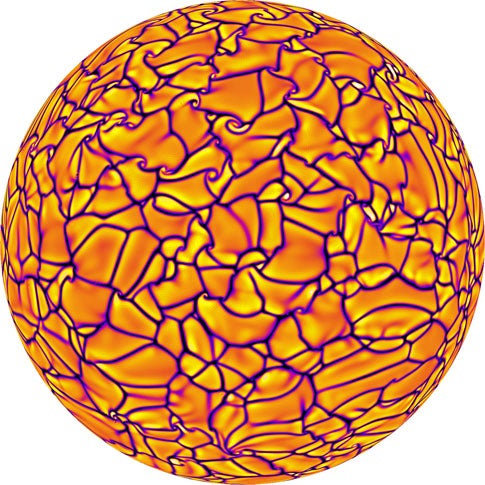A new computer model simulates convection patterns in the deep interior of the Sun in unprecedented detail. The patterns, known as giant cells, play a critical role in solar variability, influencing magnetic storms that take aim at Earth.
The model was developed by a team of scientists led by Mark Miesch of the National Center for Atmospheric Research (NCAR).
“This model provides us with an unprecedented view of how the solar interior works,” says Miesch, a scientist in NCAR’s High Altitude Observatory. “It opens a window on a number of important solar processes, including the delicate balance of forces that causes the Sun’s equator to rotate faster than its poles.”
The team, which has submitted its findings to the Astrophysical Journal, presented the research at the American Astronomical Society meeting in Honolulu on May 28.
“This is our first indication of what the chaotic interior of a star looks like,” Miesch explains. “Stars are the building blocks of the universe, and understanding what goes on within them is critical to understanding diverse aspects of astrophysics.”
Convection near the surface of the Sun occurs when hot plasma rises and cooler, denser plasma sinks, which is a process similar to what occurs in water that is heated on a stove. Convection also takes place far beneath the Sun’s surface, where scientists suspect there are churning masses of plasma up to 10 times larger than the size of Earth. These masses, known as giant cells, may hold the key to the movement of sunspots and the behavior of solar storms, which can buffet Earth’s atmosphere and affect satellites as well as power and communications systems.
To map the giant cells, Miesch and his team drew on data from helioseismology and used supercomputers to solve the equations of stellar fluid dynamics. Helioseismology is a technique to measure sound waves that propagate deep within the interior of the Sun. By analyzing variations in the light and velocity of the waves as they emerge on the Sun’s surface, scientists can glean information about hidden subsurface structures.
The model simulations capture processes in the outer 30 percent of the solar interior. They correspond to existing maps that are based on helioseismic data about subsurface processes. The simulations also capture the Sun’s unusual rotational pattern, which occurs when the giant cells redistribute angular momentum. This causes the solar equator to rotate every 28 days while higher latitudes take about 35 days.
The model reveals details about the giant cells that could help scientists learn more about the inner workings of the Sun, which are hidden from any current observational technique. The team’s simulations indicate that, at low solar latitudes, cooler and denser plasma sinks along north-south corridors, with the corridors moving eastward relative to hotter plasma that rises. But at higher latitudes, rising and falling areas of plasma meet and create solar cyclones that last for several days.
The model also can help scientists understand how giant cells induce a global circulation. The circulation, acting like a conveyor belt, moves plasma from the solar equator toward the poles just beneath the surface of the Sun and then back toward the equator at a greater depth. This circulation, working with convection and rotation, generates and organizes magnetic fields, giving rise to patterns of magnetic activity such as the 11-year sunspot cycle.










